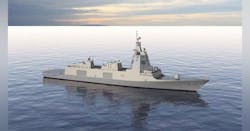Lockheed Martin to build gallium nitride (GaN)-based shipboard radar for Spanish Bonifaz-class frigate
WASHINGTON – U.S. Navy surface warfare experts needed a solid-state S-band radar for Spain's Navantia F-110 Bonifaz-class frigate surface warships. They found their solution from Lockheed Martin Corp.
Officials of the Naval Sea Systems Command in Washington announced an $82.8 million order Thursday to the Lockheed Martin Rotary and Mission Systems segment in Moorestown, N.J., for Spain F-110 radar component production and ship integration and test.
The Spain F-110 shipboard radar is based on the Lockheed Martin SPY-7 radar, which uses gallium nitride (GaN) transmit and receive modules. Lockheed Martin initially developed the SPY-7 for the U.S. Navy’s Air and Missile Defense Radar (AMDR) competition.
The company later adapted SPY-7 radar technologies into the Long-Range Discrimination Radar (LRDR) that the U.S. Missile Defense Agency (MDA) ordered as a sensor in the Ground-Based Midcourse Defense system at Clear Air Force Station, Alaska. The LRDR can discriminate between incoming warheads and decoys.
SPY-7 is a modular shipboard radar that enables Lockheed Martin to build different configurations for land- and sea-based applications. The SPY-7 has been selected by the Spanish navy to integrate with the Aegis Combat System on Spanish F-110 Bonifaz-class frigates. The Canadian navy also is procuring the radar for its Halifax-class surface combatant.
SPY-7 is a scalable radar that provides ballistic missile defense, and provides several times the performance of traditional SPY-1 radars aboard U.S. Navy Burke-class destroyers and Ticonderoga-class cruisers.
SPY-7's GaN technology allows for improved cooling of the radar, which is made up of thousands of mini scanners, which make the radar easily upgradable as threats evolve. Spain’s F-110 naval radar will go to sea in 2026 aboard the first F-110 frigate.
On this contract Lockheed Martin will do the work in Moorestown, N.J.; Ferrol and Rota Spain; Andover, Mass.; and Clearwater, Fla., and should be finished by December 2029. For more information contact Lockheed Martin Rotary and Mission Systems online at www.lockheedmartin.com, Navantia shipbuilding at www.navantia.es/en, or Naval Sea Systems Command at www.navsea.navy.mil.
About the Author
John Keller
Editor-in-Chief
John Keller is the Editor-in-Chief, Military & Aerospace Electronics Magazine--provides extensive coverage and analysis of enabling electronics and optoelectronic technologies in military, space and commercial aviation applications. John has been a member of the Military & Aerospace Electronics staff since 1989 and chief editor since 1995.
